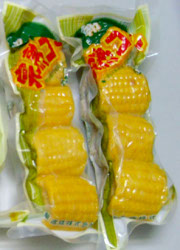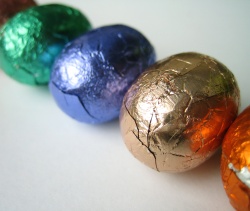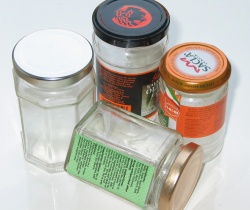What’s more important: less packaging or reusable packaging?
 At one point during the cheese course thing at the weekend, the topic of conversation turned to packaging. For us hobbyist cheese makers, it’s not an issue but for the guy running the course and the woman hoping to set up a small scale cheese company, it’s an important thing to consider: balancing appearance with food safety/durability, cost and, of course, the environmental impact.
At one point during the cheese course thing at the weekend, the topic of conversation turned to packaging. For us hobbyist cheese makers, it’s not an issue but for the guy running the course and the woman hoping to set up a small scale cheese company, it’s an important thing to consider: balancing appearance with food safety/durability, cost and, of course, the environmental impact.
Both of them were considering the well-trodden route for pre-packed cheese packaging – vacuum packed in pretty plastic wrapping – because it seems lower waste than the current option (clear plastic wrap then paper/cardboard to make them more presentable). But because you invariably have to cut into such wrapping to open it, it can’t be reused (it’s seldom even good enough to continue using around the remainder of the half-eaten product) and while the plastic – typically polythene (LDPE, resin code 4) – can be recycled, it’s not kerbside recycled everywhere and crucially, it’s often not marked so people don’t know it can be recycled.
The cheese wrapping discussion got me thinking about packaging in general, and about something I’d been thinking about since my Graze box rant last week. Following the 3Rs, we should first REDUCE, before thinking about REUSING and RECYCLING – but sometimes, in some situations, it seems better to get a larger amount/weight of packaging that’s easier to reuse or recycle.
A few examples:
- The supermarket near me sells luxury pâté in a vacuum sealed pack but the cheaper stuff in a little plastic tub. The plastic tub is heavier/sturdier so used more natural resources in its manufacture but now I can reuse it for storing small quantities of leftovers etc.
- In the past, we’ve bought luxury ready-meal desserts in reusable dishes – souffles in glass ramekins and crème brulees in shallow glazed terracotta bowls. Both the ramekins & terracotta bowls have entered our crockery supply and been in circulation for years. Plastic tubs, even reused a few times, would probably have well gone by now.
- I pick pickles & condiments in heavy glass jars rather than light, unbreakable plastic squeezy bottles because glass recycling is more efficient than plastic (and here, we can doorstep recycle glass but not plastic). I can also reuse the glass jars for preserving, saving me from having to buy new jars for that.
So what do you think? Would you prefer items to be packed in the least amount of packaging possible or prefer more packaging but something more reusable or easier to recycle? Would/do you pay more for items with reusable/recyclable packaging?
























Glass – above all / any plastic. And, yes, I would be prepared to pay more.
Ideally, I would like to revert back a couple of decades and be able to purchase from a cheese / deli counter in order that they could wrap it in brown paper in front of me – or alternatvely I would like to be able to take my own container, even a re-used one, along.
All this though would be in an idea world :-)
I think it’s a great idea to make packaging more reusable, before making it recyclable. I love when you buy a dessert and you get a great glass dish that you can keep in your cupboard – they’re so handy!
I think I would pay more for items packaged in a way where I knew it could be reused. I think if the cheaper supermarket own brands, for example Value and Smart Price were able to use better packaging that could be reused that would be brilliant, and might encourage other big brands to get on board.
I’d love easily recyclable packaging. Plastic tubs, ect, can be recycled, but the vaccum sealed plastic can’t. Plastic tubs are nice, but honesty, one can only use so many of them! Still, if I lack for ideas, I have only to look here. :)
So yes, I vote for reuseable/more easily recyclable packaging over less packaging.
Oh, plastic containers? I’ll reuse them at the health food store, where they have the bulk bins. They provide thin plastic bags, but I’d rather pay a few extra cents in weight, and use my own-I’ll show them when I go in, and they never mind.
I would also pay more for products that came in useful reusable packaging. But when it comes to everyday products you would simply end up with more tubs and containers than you could ever reuse. So I think Yeo Valley is on to a good thing with their thin plastic yoghurt tubs that are strengthened with a card label made from recycled board.
I also stay away from heavily packaged convenience food and buy loose vegetables and fruit.
Hi Anna,
That Yeo Valley thing sounds like a good compromise – is the cardboard/plastic attached together or is the cardboard a sleeve? I do hope it’s the latter as mixed materials are a pain to recycle.
I try to avoid plastic packaging. I also try to minimise packaging as much as possible. But yes there’s a balance and I’d rather have a bit more packaging that I can easily recycle than less packaging that ends up in landfill
If there are no compromises to the job (in logistical terms – design to attract is another ball game) it’s meant to do, less is best.
However, with a slight bias, reuse, especially of the designed-in variety, does have its merits!
The deli in Tescos is really annoying ‘cos they wrap cheese in cling film and then stick the price sticker over it to seal it shut. I can’t open the wrapper without tearing the cling film, so what should be reusable packaging doesn’t even last long enough to keep the rest of the cheese covered in the fridge when I’ve used a bit.
On the plus side, Nutella. Hooray for chocolate, packaged in a plain glass suitable for reusing for years as a normal drinking glass, with a reusable plastic cover just the right size to use as a tin cover for half-used tins of food kept in the fridge. The perfect packaging!
Huh? nutela is packaged in those plastic jars that are also used for peanut butter(it can be reused though.) maybe its different in england. im american.
It’s either in a glass tumbler here –
http://iamfromsouth.free.fr/dotclear/images/Nutella-glass.jpg
Or the bigger size is in a glass jar with a plastic screw top lid –
http://iamfromsouth.free.fr/dotclear/images/Nutella-pot.jpg
Both very reusable!
We recycle ourselves as a business model. But over the longer term we absolutely agree that re using packaging and making things last longer is the ultimate business model.
And the more sustainable model for all resource usage. Even very well organised plastic recycling has some carbon footprint.
Hi Louisa,
Nice to hear you’re reusing glass!
Overpackaging is a big problem, but when you switch to glass you know it preserves longer and it can be reused.
I love glass: not only is it one of the most beautiful materials there is, but it’s also good for the environment. And food and drinks taste so much better out of a glass, don’t you think? From one friend of glass to another: thanks again for your recycling efforts.
Kind regards,
Nickias
Friends of Glass